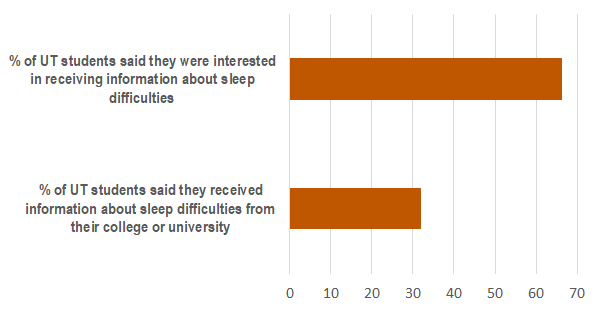Sleep Promotion
UT Austin students, like many students across the country, are not getting enough sleep. Roughly 74 percent of UT Austin students reported feeling sleepy or tired for three to seven of the past seven days. Students rank sleep difficulties (21.6 percent) only behind stress (39.4 percent) and anxiety (27.3 percent) when asked about the impacts to their academic performance (American College Health Association-National College Health Assessment, 2019).
In one study, 82 percent of college students believe that inadequate sleep and sleepiness impact their school performance (Hershner & Chervin, 2014), and research supports their claims. Insufficient sleep has been linked to decreased memory consolidation, learning, decision making, critical thinking and a greater frequency of stress (Batterink, Westerberg, & Paller, 2017; Lemma et al., 2014; Dusselier et al., 2005).
Sleep plays a bigger role in GPA than most would assume. Students who get seven to nine hours of sleep had higher grade point averages than students who did not get that much sleep regularly (Yu & Arendt, 2017). Sleep habits, in particular weekday and weekend wake up times, had the greatest effect on GPA, even greater than other variables including eating breakfast, exercise, gender and age (Trockel, Barnes, & Egget, 2000).

Data shows that UT students want resources about how to get a better night’s sleep. The chart above illustrates the discrepancy that currently exists between students who have received information about sleep difficulties (about 33 percent) and those who are interested in receiving more information (about 66 percent) (American College Health Association-National College Health Assessment, 2017).
Faculty can play an active role in encouraging healthy sleep habits in students. The following examples show how you can promote good sleep habits among your students.
In your syllabus and Canvas page
- Adjust assignment deadlines in Canvas from the default of midnight to 8 p.m. or earlier to ensure students are not staying up until midnight to finish assignments.
- Link the Longhorn Wellness Center (LWC) sleep page under resources and point out how students will benefit academically, physically and emotionally by prioritizing sleep. Find examples of syllabus statements.
- Space out assignments and exams through the semester to limit intensified times of work. Use this workload estimator to calculate the approximate time students spend each week on work for your course.
Assignments
- Integrate wellness and goal-setting activities in class that include assessing sleep habits.
- Order free sleep kits, each of which contains an eye mask, earplugs, lavender spray, mini-journal, herbal tea and resources for your class. Have students complete a written or verbal reflection on how they used the kit to aid their sleep.
- Create an assignment where students track their sleep for one week using a sleep diary to identify barriers and sleep strategies.
- Have students complete the Healthyhorns Sleep Assessment to obtain tailored and personalized feedback about their sleep habits.
In Class
- A few days before and the day before an exam, remind students not to pull all-nighters, and discuss the positive academic impacts of getting seven to nine hours of sleep consistently and prior to exams.
- At the end of class, offer a sleep tip or debunk a sleep myth. You can find many examples on our sleep page.
- If you notice students falling asleep in class, do not call them out or embarrass them. Approach them after class and check-in one on one. This may involve referring the student for support services through University Health Services or the Counseling and Mental Health Center and/or discussing workload and balance.
- Invite a Longhorn Wellness Center coordinator or Longhorn Wellness Peer Educators to talk about sleep health and other wellness issues. Request an LWC workshop.
References
American College Health Association. (2017). American College Health Association-National College Health Assessment II: University of Texas at Austin Institutional Data Report Spring 2017. Hanover, MD: American College Health Association.
American College Health Association. (2019). American College Health Association-National College Health Assessment II: University of Texas at Austin Institutional Data Report Fall 2019. Hanover, MD: American College Health Association.
Batterink, L. J., Westerberg, C. E., & Paller K. A. (2017). Vocabulary learning benefits from REM after slow-wave sleep. Neurobiology of Learning ≈ Memory, 144, 102-113.
Dusselier, L., Dunn, B., Wang, Y., Shelley, M.C. & Whalen D.F. (2005) Personal, Health, Academic, and Environmental Predictors of Stress for Residence Hall Students. Journal of American College Health, 54(1), 15-24.
Hershner, S. D., & Chervin, R. D. (2014). Causes and consequences of sleepiness among college students. Nature and Science of Sleep, 6, 73–84. http://doi.org/10.2147/NSS.S62907
Lemma, S., Berhane, Y., Worku, A., Gelaye, B., & Williams, M. A. (2014). Good Quality Sleep is Associated with Better Academic Performance among University Students in Ethiopia. Sleep & Breathing = Schlaf & Atmung, 18(2), 257–263. http://doi.org/10.1007/s11325-013-0874-8
Trockel, M., Barnes, M., & Egget, D. (2000). Health-related variables and academic performance among first-year college students: Implications for sleep and other behaviors. Journal of American College Health, 49, 125–131.
Yu, C. Arendt, S.W. (2017). Benefits of Sleep for Undergraduate Students’ Academic Performance. Journal of Hospitality & Tourism Education, 29(2). http://dx.doi.org/10.1080/10963758.2017.1297713



